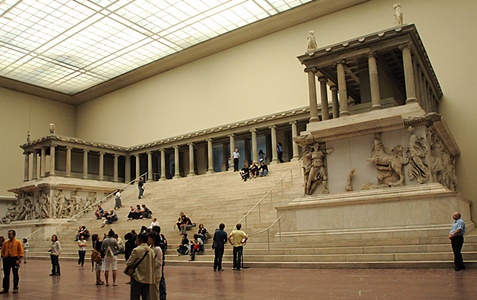Print Article
Author's Bias | Interpretation: conservative | Inclination: dispensational | Seminary: none
Pergamum (Greek: Pergamon) was an ancient Greek city that was located on a 1,000-foot Pergamum Acropolis hill
near the modern-day city of Bergama, Izmir Province, Turkey. In 1871, while supervising the construction of a road
in Pergamum, German engineer Carl Humann discovered marble architectural pieces and reliefs.
The Great Altar of Pergamum was largely unknown save a single mention by an ancient author. The
Latin writer Lucius Ampelius (Liber Memorialis) wrote, "At Pergamum there is a great marble altar, 40 feet (12 m)
high, with colossal sculptures, representing a battle of the giants."
When Humann brought the pieces back to Berlin, scholars suspected that they might be pieces of
the Great Altar of Pergamum.
The first serious archaeological excavation, during 1878-1886, recovered the altar's foundation, 132 relief
panels, and hundreds of fragments from reliefs, statues, inscriptions and architectural pieces. Shipped back to
Germany, the Great Altar has only had its entire front entrance, that faced west, reconstructed.

© Silvio Sorcini
Notable for the quality and quantity of marble used in its construction, the most acclaimed features of the
Great Altar were the relief friezes that occupied two levels of the monument:
Beneath the colonnade, below the platform of the altar, one relief frieze runs from one podium
and around the back of the monument to the other podium; only the side with the stairs ascending to the level of
the altar lacks this relief frieze. Three quarters of this frieze was recovered and contained more than one hundred
larger than life figures portraying animals and a battle between giants and Greek gods / goddesses. It was a battle
between chaos and order, and the gods / goddesses were celebrated with their names appearing above each one.
At the level of the colonnade and enclosing the altar inside, three walls portray the life story
of Telephos, the son of Heracles / Hercules, and legendary founder of Pergamum. Citizens of Pergamum believed, at
one time, that their rulers were descendants of Heracles and his father Zeus. Only one third of this frieze was
recovered.
Pergamum was the fortress capital city of the Attalid empire (282-133 B.C.) and was at its zenith under its
fourth king, Eumenes II (reign 197-159 B.C.), who built the Great Altar and remodeled the nearby sanctuaries of
the pagan gods Zeus and Athena. Scholars believe that the Great Alter served as a place for sacrifices either
limited to Zeus or for both Zeus and Athena. Recognized as one of the main centers of Greek culture, Pergamum
included a library that rivaled the library of Alexandria with over 200,000 volumes.
By 129 B.C., Pergamum was in firm control by the Romans who included the city in its Asia Province with its
new capital in Ephesus. A century later (29 A.D.), Augustus authorized the construction of Rome's first Imperial
Cult Temple dedicated to a Roman ruler; however, the remains of this temple has not been found. It would be later
that a Roman ruler would build the only recovered Roman structure on the Pergamum Acropolis to rival the Great
Altar, Trajan's (reign 98-117 A.D.) Imperial Cult Temple.
Mentioned twice in the book of Revelation (Rev 2:12-13),
Pergamum was the city which the apostle John writes as having "Satan's throne"
(Rev 2:13). Because the Great Altar was Pergamum's most
significant pagan cult structure in existence during the time of the apostle John's writing (96 A.D.), scholars
hypothesize that "Satan's throne" was a reference to the Great Altar.
There is some similarity seen in the earthly "throne" of God. The lid of the Ark of the
Covenant was where God came to communicate with Moses. The lid, also knowns as the "Mercy Seat," was the
"place of propitiation,"
which received the blood of a sacrificed bull and goat on the Day of Atonement.
References:
1. Fant CE and Reddish MG, Lost Treasures of the Bible, Grand Rapids: Eeardmans Publishing (2008).
2. Chisholm H, ed. "Ampelius, Lucius" in Encyclopaedia Britannica (11th ed.), Cambridge: Cambridge University Press (1911).
3. From the BiblicalArchaeology.org website: Ancient Pergamon.
4. From the University of Oxford Beazley Archive website: The Great Altar at Pergamon.
5. From the Livius.org website: Pergamon.
Copyright ©
2018
Helpmewithbiblestudy.org. All rights to this material are reserved. We encourage you to print the material for personal and
non-profit use or link to this site. If you find this article to be a blessing, please share the link so that it may rise in
search engine rankings.